Haddo Peak facts for kids
Quick facts for kids Haddo Peak |
|
|---|---|

Haddo Peak
|
|
| Highest point | |
| Elevation | 3,070 m (10,070 ft) |
| Prominence | 83 m (272 ft) |
| Parent peak | Mount Aberdeen (3157 m) |
| Listing | Mountains of Alberta |
| Geography | |
| Location | Alberta, Canada |
| Parent range | Bow Range Canadian Rockies |
| Topo map | NTS 82N/08 |
| Type of rock | Sedimentary |
| Climbing | |
| First ascent | 1903 by E. Tewes, C. Bohren |
| Easiest route | Technical climb via Southwest Ridge |
Haddo Peak is a mountain peak found in Alberta, Canada. It is located in the beautiful Lake Louise area, which is part of Banff National Park.
The mountain was named in honor of George Gordon, Lord Haddo. He was a Scottish nobleman and politician. The name was chosen in 1916 and officially recognized in 1952.
Understanding Haddo Peak's Rocks
Like other mountains in Banff National Park, Haddo Peak is made of a type of rock called sedimentary rock. This kind of rock forms from layers of sand, mud, and tiny bits of sea creatures that settle at the bottom of ancient seas.
These layers of rock were laid down over millions of years, from the Precambrian period (a very long time ago) to the Jurassic period (when dinosaurs lived). Later, huge forces within the Earth pushed these rock layers up. This created the tall mountains we see today in the Canadian Rockies. This mountain-building process is called the Laramide orogeny.
Weather at Haddo Peak
Haddo Peak is in a subarctic climate zone. This means it has very cold and snowy winters. Summers are usually mild, not too hot.
In winter, temperatures can drop below -20 °C (which is -4 °F). With the wind chill, it can feel even colder, sometimes below -30 °C (-22 °F). If you plan to visit, the best time for climbing is during the summer months. The weather is much nicer then!




